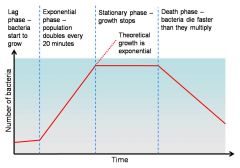![]()
![]()
![]()
Use LEFT and RIGHT arrow keys to navigate between flashcards;
Use UP and DOWN arrow keys to flip the card;
H to show hint;
A reads text to speech;
28 Cards in this Set
- Front
- Back
|
Which factors do we look at when classifying bacteria ?
|
1. Gram stain
2. Morphology 3. Metabolic properties |
|
|
What solid substance is used when culturing bacteria ?
|
Agar.
|
|
|
What is the temperature at which bacteria is cultured ?
|
37 degrees Celsius (human body temperature).
|
|
|
What is the plate called on which bacteria is cultured ?
|
Petri.
|
|
|
What is the advantage of a solid media over a liquid media (in terms of culturing bacteria) ?
|
By using a solid media it is possible to isolate pure cultures of bacteria from a mixture of organisms.
|
|
|
Apart from solid and liquid media, into which three other categories can culturing media be divided into ?
|
1. Simple
2. Enriched 3. Selective |
|
|
What is the difference between enriched and selective culturing media ?
|
Enriched media promotes the growth of a particular organism, whereas selective does the same but also inhibits the growth of others.
|
|
|
True or false: Gram staining mycobacteria will result in a gram positive result.
|
False. Mycobacteria is impermeable to the dyes used in Gram staining.
|
|
|
Because of the nature of mycobacteria's cell wall, which staining method would you use to determine if mycobacteria is Gram positive or negative.
|
Zhiel-Neelsen staining method.
|
|
|
True or false: Treponema is not visible on an ordinary light microscope.
|
True.
|
|
|
What are the requirements for bacterial growth ?
|
1. Harmless envrionment
2. Nutrients |
|
|
What is the difference between obligate anaerobes and facultative anaerobes ?
|
Facultative anaerobes can survive in the presence or absence of oxygen, whereas obligate anaerobes can only survive in the absence of oxygen.
|
|
|
What are two methods that bacteria can protect themselves from the environment ?
|
1. Capsules
2. Biofilm matrix |
|
|
Define: Sporulation.
|
The process by which specialized cells called spores are formed by certain bacteria when there is inadequate nutrition.
|
|
|
True or false: In an unstable climate spores will tend to be destroyed.
|
False. Spores are very resistant to drying, heat, freezing, chemical agents and radiation.
|
|
|
Define: Quorum sensing.
|
A system of stimulus and responses (mediated by chemical messages) whereby bacterial cells are aware of the population density in a specific environment.
|
|
|
True or false: Bacteria are able to verbally communicate with each other.
|
False. Bacteria communicate via chemical messengers.
|
|
|
Draw a graph of a typical bacterial growth curve.
|

|
|
|
What does the capsule surrounding a bacteria usually consist of ?
|
Polysaccharides.
|
|
|
Which structures found on the surface of the bacteria are very important for the following actions:
1. Adhesion to other bacteria 2. Movement 3. Creation of biofilm |
1. Pili
2. Flagella 3. Glycocalyx |
|
|
What are the major differences between a eukaryotic and a prokatyotic cell ?
|
Eukaryotes:
1. Nucleolus present with a surrounding membrane and multiple chromosomes 2. Contains mitochondria and chloroplasts for respiration 3. No peptidoglycans in cell wall (if present) Prokaryotes: 1. No nucleolus and nuclear membrane; and only a single chromosome is present 2. Respiratory enzymes are located in peripheral cytoplasmic membrane 3. Peptidoglycans present in cell wall |
|
|
What is the function of a bacterial cell wall ?
|
1. Rigidity
2. Protection against osmotic pressure 3. Selective permeability 4. Adhesive properties |
|
|
What is the importance of a bacterial cell wall in terms of defense against infection ?
|
1. Host immune system recognizes the cell wall easily
2. Important targets for antimicrobial drugs |
|
|
In which bacteria would you find a periplasmic space ?
|
Gram negative bacteria only.
|
|
|
What is the function of teichoic acid located in bacterial cell walls ?
|
It strengthens the cell walls.
|
|
|
Name the common components of a bacterial cell wall.
|
1. Peptidoglycans
2. Teichoic acid 3. Lipopolisacharides 4. Pili 5. Flagella 6. Capsules 7. Periplasmic space 8. Plasma membrane |
|
|
Why is the peptidoglycan layer thicker in Gram positive bacteria than in Gram negative bacteria ?
|
Usually the osmotic pressure is much higher in Gram negative bacteria, therefore the layer of peptidoglycan layers are much thicker.
|
|
|
What is responsible for endotoxic shock and what is its origin ?
|
Lipopolysaccharides are also known as endotoxin which is responsible for endotoxic shock.
|

